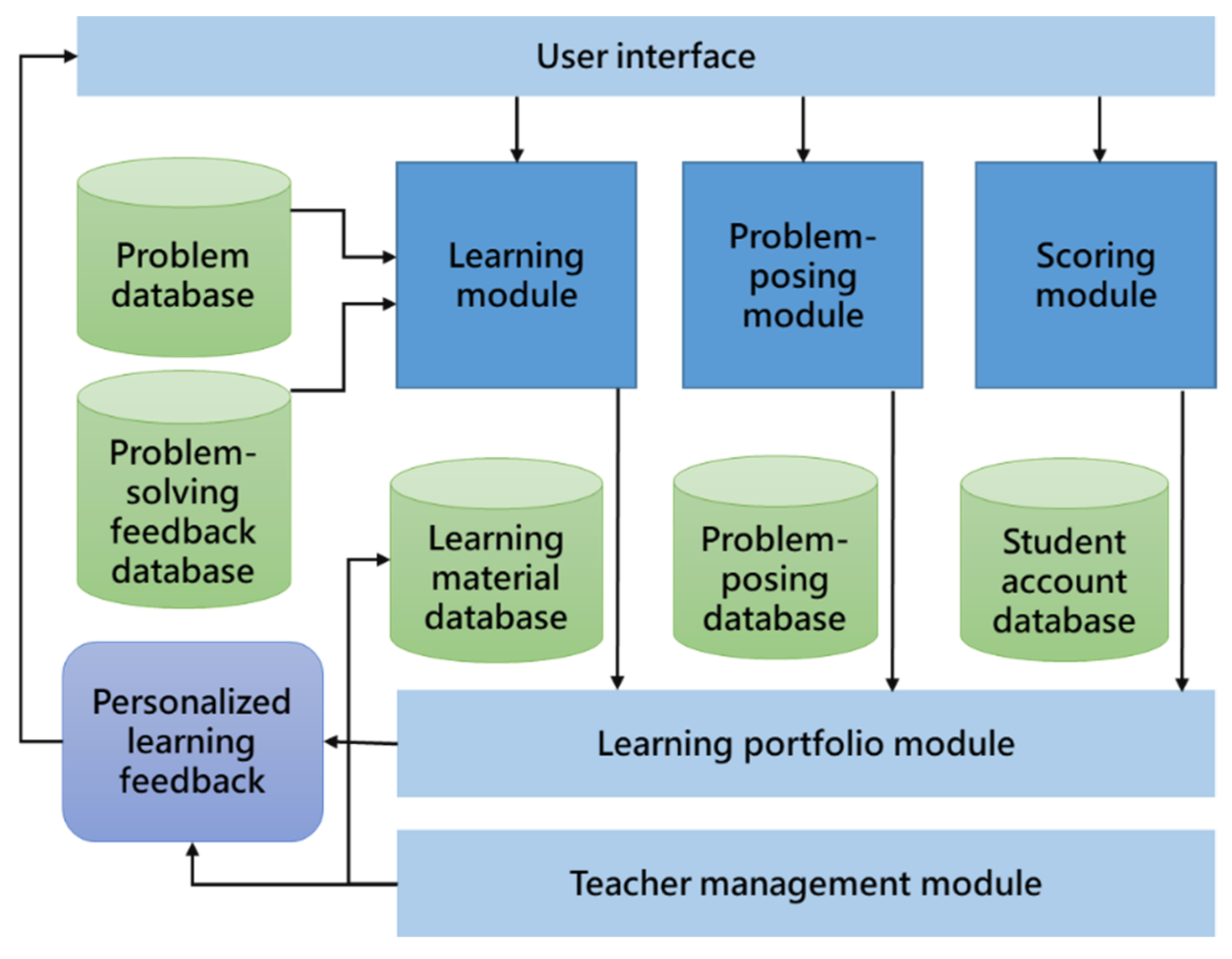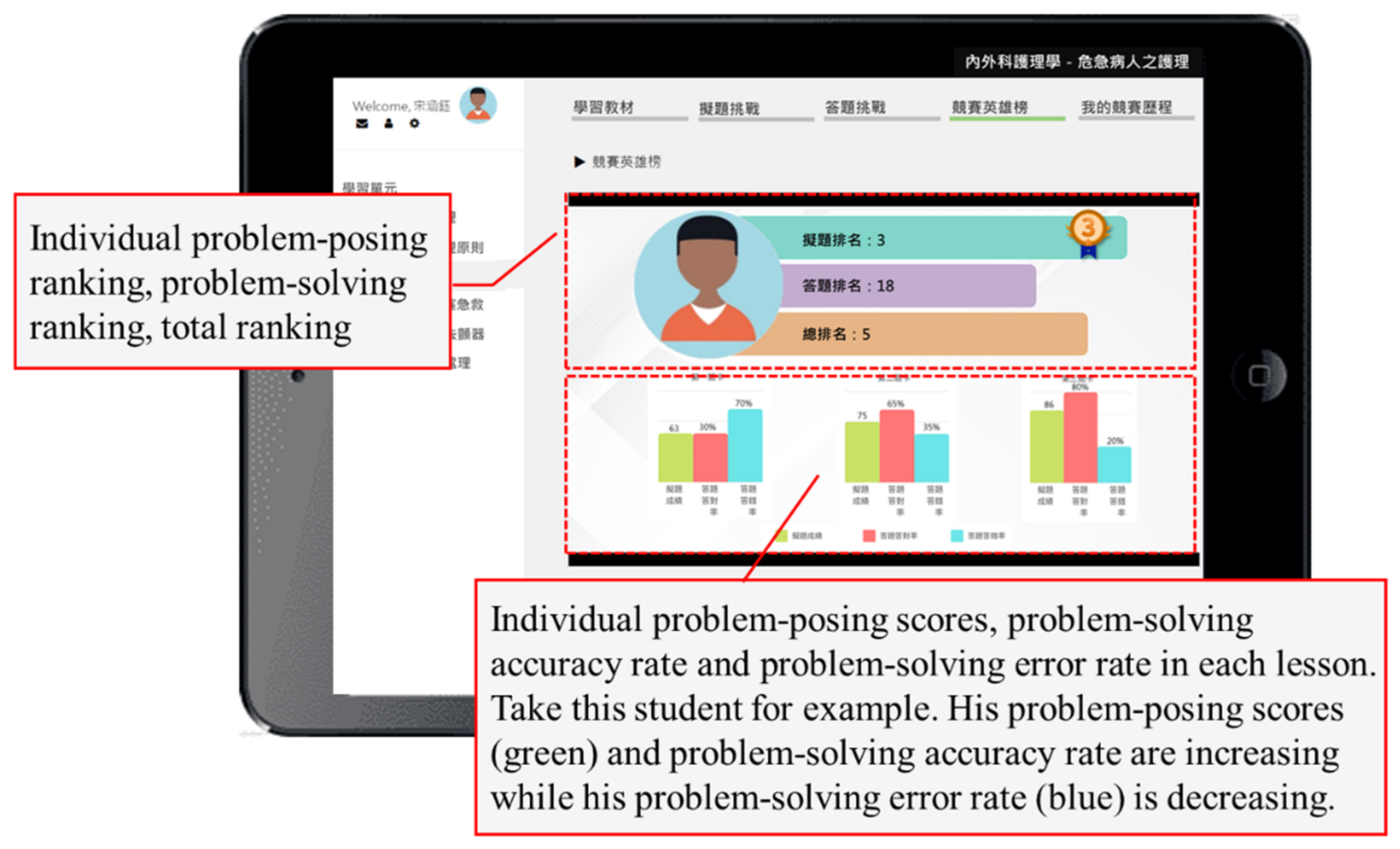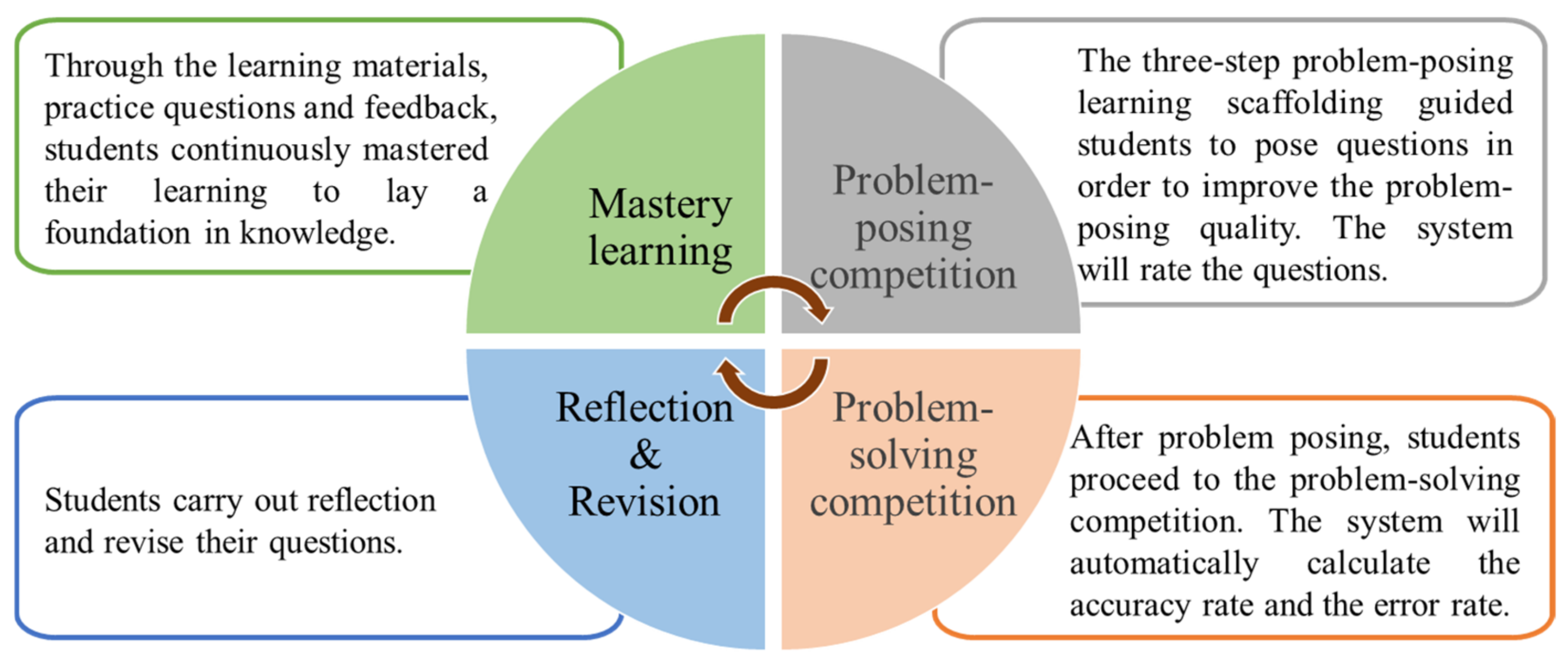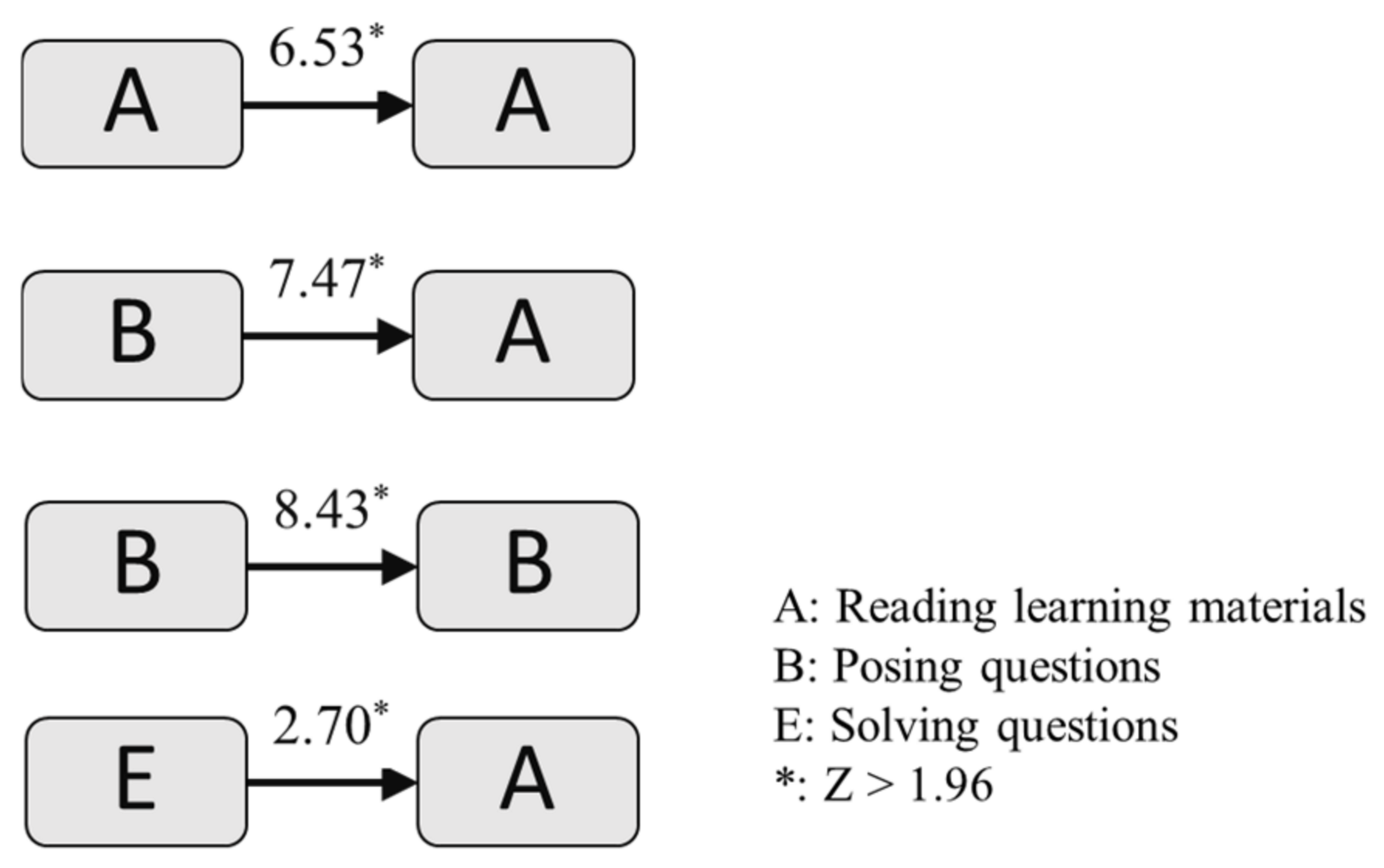A Competition-Based Problem-Posing Approach for Nursing Training
Abstract
:1. Introduction
- Are there any significant differences between the learning achievement of students who adopt the competition-based problem-posing approach and the conventional problem-posing approach?
- Are there any significant differences between the learning motivation of students who adopt the competition-based problem-posing approach and the conventional problem-posing approach?
- What are the effects of the competition-based problem-posing approach on students’ learning behaviors?
2. Literature Review
2.1. Competition
2.2. Problem-Posing
3. Methods
3.1. Development of a Competition-Based Problem-Posing Learning Environment
3.2. Participants and the Teaching Unit
3.3. Experimental Procedure
3.4. Measuring Tools
3.5. Data Analysis
4. Results
4.1. Analysis of Learning Achievement
4.2. Analysis of Learning Motivation
4.3. Analysis of Cognitive Load
4.4. Analysis of Learning Behaviors
5. Discussion and Conclusions
Funding
Institutional Review Board Statement
Informed Consent Statement
Data Availability Statement
Acknowledgments
Conflicts of Interest
References
- Smith, K.K.; Gilcreast, D.; Pierce, K. Evaluation of staff’s retention of ACLS and BLS skills. Resuscitation 2008, 78, 59–65. [Google Scholar] [CrossRef] [PubMed]
- Allen, J.A.; Currey, J.; Considine, J. Annual resuscitation competency assessments: A review of the evidence. Aust. Crit. Care. 2013, 26, 12–17. [Google Scholar] [CrossRef] [PubMed] [Green Version]
- Yassi, A.; Hancock, T. Patient safety-worker safety: Building a culture of safety to improve healthcare worker and patient well-being. Healthc. Q. 2005, 8, 32–38. [Google Scholar] [CrossRef] [PubMed] [Green Version]
- Agnew, C.; Flin, R.; Mearns, K. Patient safety climate and worker safety behaviours in acute hospitals in Scotland. J. Saf. Res. 2013, 45, 95–101. [Google Scholar] [CrossRef] [PubMed]
- Brown, S.I.; Walter, M.I. Problem Posing: Reflections and Applications; Psychology Press: New York, NY, USA, 2014. [Google Scholar]
- Barlow, A.; Cates, J.M. The impact of problem posing on elementary teachers’ beliefs about mathematics and mathematics teaching. Sch. Sci. Math. 2006, 106, 64–73. [Google Scholar] [CrossRef]
- Silver, E.A.; Cai, J. Assessing students’ Mathematical Problem Posing. J. Math. Teach. Educ. 2005, 12, 129–135. [Google Scholar] [CrossRef]
- Sung, H.Y.; Hwang, G.J.; Chang, Y.C. Development of a mobile learning system for local culture courses based on a collaborative problem-posing strategy. Interact. Learn. Environ. 2016, 24, 456–471. [Google Scholar] [CrossRef]
- Chang, C.Y.; Chung, M.H.; Yang, J.C. Facilitating nursing students’ skill training in distance education via online game-based learning with the watch-summarize-question approach during the COVID-19 pandemic: A quasi-experimental study. Nurse Educ. Today 2022, 109, 105256. [Google Scholar] [CrossRef]
- Lin, H.C.; Hwang, G.J.; Hsu, Y.D. Effects of ASQ-based flipped learning on nurse practitioner learners’ nursing skills, learning achievement and learning perceptions. Comput. Educ. 2019, 139, 207–221. [Google Scholar] [CrossRef]
- Hanrahan, S.J.; Isaacs, G. Assessing Self- and Peer-assessment: The students’ views. High. Educ. Res. Dev. 2001, 20, 53–70. Available online: https://www.tandfonline.com/doi/abs/10.1080/07294360123776 (accessed on 1 January 2022). [CrossRef]
- Liu, Z.F.; Chiu, C.H.; Lin, S.S.J.; Yuan, S.M. Web-based peer review: The learner as both adapter and reviewer. IEEE Trans. Educ. 2001, 44, 246–251. Available online: https://www.semanticscholar.org/paper/Web-based-peer-review%3A-the-learner-as-both-adapter-Liu-Lin/21e85ed132b6db54d16504f0ea479f7440ca69d9 (accessed on 15 January 2022).
- Stovanova, E.; Ellerton, N.F. A framework for research into student’s problem posing in school mathematics. In Talking Mathematics: Supporting Children’s Voices; Corwin, R.B., Ed.; Heinemann: London, UK, 1996. [Google Scholar]
- Yu, F.Y.; Liu, Y.H. Potential values of incorporating multiple-choice question-construction for physics experimentation instruction. Int. J. Sci. Educ. 2005, 27, 1319–1335. Available online: https://www.semanticscholar.org/paper/Potential-Values-of-Incorporating-a-Multiple%E2%80%90Choice-Yu-Liu/9b0c27375083cd9b00e8f77cee882252f99116f5 (accessed on 19 January 2022). [CrossRef]
- Casey, M.M.; Bates, S.P.; Galloway, K.W.; Galloway, R.K.; Hardy, J.; Kay, A.E.; Kirsop, P.; McQueen, H.A. Student-Generated Content: Enhancing learning through sharing multiple-choice questions. Int. J. Sci. Educ. 2014, 36, 2180–2194. Available online: https://www.tandfonline.com/doi/abs/10.1080/09500693.2014.916831 (accessed on 15 January 2022).
- Chang, K.E.; Wu, L.J.; Weng, S.E.; Sung, Y.T. Embedding game-based problem-solving phase into problem-posing system for mathematics learning. Comput. Educ. 2012, 58, 775–786. Available online: https://www.learntechlib.org/p/50850/ (accessed on 19 January 2022). [CrossRef]
- Yu, F.Y.; Chen, Y.J. Effects of student-generated questions as the source of online drill-and-practice activities on learning. Br. J. Educ. Technol. 2014, 45, 316–329. Available online: https://www.semanticscholar.org/paper/Effects-of-student-generated-questions-as-the-of-on-Yu-Chen/c44472a26bd9a249dfcffdff75caa6b805578462 (accessed on 15 January 2022). [CrossRef]
- Lai, C.L.; Hwang, G.J. Effects of mobile learning time on students’ conception of collaboration, communication, complex problem-solving, meta-cognitive awareness and creativity. Int. J. Mob. Learn. Organ. 2014, 8, 276–291. Available online: https://www.semanticscholar.org/paper/Effects-of-mobile-learning-time-on-students’-of-and-Lai-Hwang/6928d517dcad30be03db380e6a9413da53f3369e (accessed on 19 January 2022). [CrossRef]
- Admiraal, W.; Huizenga, J.; Akkerman, S.; Ten Dam, G. The concept of flow in collaborative game-based learning. Comput. Hum. Behav. 2011, 27, 1185–1194. Available online: https://www.researchgate.net/publication/220496074_The_concept_of_flow_in_collaborative_game-based_learning (accessed on 19 January 2022). [CrossRef] [Green Version]
- Wong, L.H.; Hsu, C.K.; Sun, J.; Boticki, I. How Flexible Grouping Affects the Collaborative Patterns in a Mobile-Assisted Chinese Character Learning Game. J. Educ. Techno. Soc. 2013, 16, 174–187. Available online: https://www.semanticscholar.org/paper/How-Flexible-Grouping-Affects-the-Collaborative-in-Wong-Hsu/fb358e6278e14293d671e9cbd8fde47e86726d96 (accessed on 19 January 2022).
- Johnson, R.T.; Johnson, D.W.; Stanne, M.B. Effects of cooperative, competitive, and individualistic goal structures on computer-assisted instruction. J Educ Psychol. 1985, 77, 668. Available online: https://psycnet.apa.org/doiLanding?doi=10.1037%2F0022-0663.77.6.668 (accessed on 19 January 2022). [CrossRef]
- Alorda, B.; Suenaga, K.; Pons, P. Design and evaluation of a microprocessor course combining three cooperative methods: SDLA, PjBL and CnBL. Comput Educ. 2011, 57, 1876–1884. Available online: https://www.researchgate.net/publication/220140594_Design_and_evaluation_of_a_microprocessor_course_combining_three_cooperative_methods_SDLA_PjBL_and_CnBL (accessed on 19 January 2022). [CrossRef]
- Burguillo, J.C. Using game theory and competition-based learning to stimulate student motivation and performance. Comput Educ. 2010, 55, 566–575. Available online: https://www.researchgate.net/publication/222785687_Using_game_theory_and_Competition-based_Learning_to_stimulate_student_motivation_and_performance (accessed on 19 January 2022). [CrossRef]
- Lin, C.P.; Wang, Y.J.; Tsai, Y.H.; Hsu, Y.F. Perceived job effectiveness in coopetition: A survey of virtual teams within business organizations. Comput. Hum. Behav. 2010, 26, 1598–1606. Available online: https://www.semanticscholar.org/paper/Perceived-job-effectiveness-in-coopetition%3A-A-of-Lin-Wang/a3defdd7b7b2869dd7119e224062fb4e05462f35 (accessed on 19 January 2022). [CrossRef]
- Schmierbach, M. ‘‘Killing spree’’: Exploring the connection between competitive game play and aggressive cognition. Commun. Res. 2010, 37, 256–274. Available online: https://www.semanticscholar.org/paper/%E2%80%9CKilling-Spree%E2%80%9D%3A-Exploring-the-Connection-Between-Schmierbach/d184913ba804c4304ca3d0567bc14ddf58373efe (accessed on 25 January 2022). [CrossRef]
- Cagiltay, N.E.; Ozcelik, E.; Ozcelik, N.S. The effect of competition on learning in games. Comput Educ. 2015, 87, 35–41. Available online: http://repository.bilkent.edu.tr/handle/11693/21181 (accessed on 25 January 2022). [CrossRef]
- Ke, F. Computer games application within alternative classroom goal structures: Cognitive, metacognitive, and affective evaluation. Educ. Technol. Res. Dev. 2008, 56, 539–556. Available online: https://link.springer.com/article/10.1007/s11423-008-9086-5 (accessed on 25 January 2022). [CrossRef]
- Peng, W.; Hsieh, G. The influence of competition, cooperation, and player relationship in a motor performance centered computer game. Comput. Hum. Behav. 2012, 28, 2100–2106. Available online: https://www.semanticscholar.org/paper/The-influence-of-competition%2C-cooperation%2C-and-in-a-Peng-Hsieh/cf1643102d85531e14985777c0db9d73538db742 (accessed on 25 January 2022). [CrossRef]
- Coakley, J. Sport in Society: Issues and Controversies, 4th ed.; Times Mirror/Mosbey College: St. Louis, MI, USA, 1994; Available online: https://www.cabdirect.org/cabdirect/abstract/19921899670 (accessed on 25 January 2022).
- Goldman, M.; Stockbauer, J.W.; McAuliffe, T.G. Intergroup and intragroup competition and cooperation. J. Exp. Soc. Psychol. 1977, 13, 81–88. Available online: https://www.sciencedirect.com/science/article/abs/pii/0022103177900154 (accessed on 25 January 2022). [CrossRef]
- Hammer, R.; Ronen, M.; Kohen-Vacs, D. On-line project-based peer assessed competitions as an instructional strategy in higher education. IJELLO 2012, 8, 179–192. Available online: https://www.learntechlib.org/p/44769/ (accessed on 25 January 2022). [CrossRef]
- Domínguez, A.; Saenz-De-Navarrete, J.; De-Marcos, L.; FernáNdez-Sanz, L.; PagéS, C.; MartíNez-HerráIz, J.J. Gamifying learning experiences: Practical implications and outcomes. Comput. Educ. 2013, 63, 380–392. Available online: https://www.sciencedirect.com/science/article/abs/pii/S0360131513000031?via%3Dihub (accessed on 25 January 2022). [CrossRef]
- Hwang, G.J.; Chang, S.C. Effects of a peer competition-based mobile learning approach on students’ affective domain exhibition in social studies courses. Br. J. Educ. Technol. 2016, 47, 1217–1231. [Google Scholar] [CrossRef]
- Nonaka, I.; Umemoto, K.; Sasaki, K. Managing and measuring knowledge in organizations. In Knowledge in Firms: Understanding, Managing and Measuring Knowledge; von Krogh, G., Roos, J., Kleine, D., Eds.; Sage: Thousand Oaks, CA, USA, 1998; pp. 146–172. [Google Scholar]
- Dolgov, I.; Graves, W.J.; Nearents, M.R.; Schwark, J.D.; Brooks Volkman, C. Effects of cooperative gaming and avatar customization on subsequent spontaneous helping behavior. Comput. Hum. Behav. 2014, 33, 49–55. [Google Scholar] [CrossRef]
- Chen, Z.H. Exploring students’ behaviors in a competition-driven educational game. Comput. Hum. Behav. 2014, 35, 68–74. Available online: https://www.infona.pl/resource/bwmeta1.element.elsevier-f1dc8746-9970-3074-b67f-1826858e4e50 (accessed on 1 February 2022). [CrossRef]
- Hwang, G.J.; Yang, L.H.; Wang, S.Y. A concept map-embedded educational computer game for improving students’ learning performance in natural science courses. Comput. Educ. 2013, 69, 121–130. Available online: https://www.sciencedirect.com/science/article/pii/S0360131513001759?casa_token=OZ41OaA_thkAAAAA:h9ramyJ_bu6mYifVzl4rzxOHp1D4s_rpxuCFdNDqVvQfxBcffwHOhhOgZ1sDt19rLMu5_pyt8ivS (accessed on 1 February 2022). [CrossRef]
- Deutsch, M. The Resolution of Conflict: Constructive and Destructive Processes; Yale University Press: New Haven, CT, USA, 1973. [Google Scholar]
- Wang, A.I. The wear out effect of a game-based student response system. Comput. Educ. 2015, 82, 217–227. Available online: https://www.semanticscholar.org/paper/The-wear-out-effect-of-a-game-based-student-system-Wang/1e8cad97e1015d358b8778084211a01b36b4d629 (accessed on 1 February 2022). [CrossRef] [Green Version]
- Lin, K.M.; Leng, L.W. Using Problem-Posing as an Assessment Tool. In Proceedings of the 10th Asia-Pacific Conference on Giftedness, Singapore, 14 July 2008; Available online: https://scholar.google.com/scholar?hl=en&as_sdt=0%2C5&q=6.%09Lin%2C+K.+M.%2C+%26+Leng+L.+W.+%282008%29.+Using+problem-posing+as+an+assessment+tool.+Paper+presented+at+the+10th+Asia-Pacific+Conference+on+Giftedness%2C+2008%2C+Singapore.&btnG= (accessed on 1 February 2022).
- Polya, G. How to Solve It, 2nd ed.; Doubleday: New York, NY, USA, 1945. [Google Scholar]
- Tsubota, E. On children’s Problem Posing (Grade 1 to 3); Japan Society of Mathematics Education: Tokyo, Japan, 1987. [Google Scholar]
- Leung, S.S. Mathematical Problem Posing: The Influence of Task Formats, Mathematics Knowledge, and Creative Thinking. In Proceedings of the 17th International conference of the International Group for the psychology of Mathematics Education, Tsukuba, Japan, 18–23 July 1993; Hirabayashi, I., Nohda, N., Shigematsu, K., Lin, F., Eds.; The International Group for the Psychology of Mathematics Education (PME): Karlsruhe, Germany, 1993; Volume 3, pp. 33–40. Available online: https://flm-journal.org/Articles/2A5D152778141F58C1966ED8673C15.pdf (accessed on 1 February 2022).
- Abramovich, S.; Cho, E.K. Technology as a medium for elementary preteachers’ problem-posing experience in mathematics. Int. J. Sci. Math. Educ. 2006, 25, 309–323. Available online: https://www.semanticscholar.org/paper/Technology-as-a-Medium-for-Elementary-Preteachers%27-Abramovich-Cho/3e19d7c0901411e83d633964c734f3c59dbbe3f1 (accessed on 1 February 2022).
- Mason, J. Asking mathematical questions mathematically. Int. J. Math. Educ. Sci. Technol. 2000, 31, 97–111. Available online: https://www.semanticscholar.org/paper/Asking-mathematical-questions-mathematically-Mason/5f886e460a882d6c682a0755573d8bacbbcd3bf3 (accessed on 1 February 2022). [CrossRef]
- Skinner, P. What’s Your Problem: Posing and Solving Mathematical Problems, K-2; Heinemann: Portsmouth, UK, 1991. [Google Scholar]
- Arikan, E.E.; Unal, H. Investigation of problem-solving and problem-posing abilities of seventh-grade students. Kuram Ve Uygul. Egit. Bilimleri 2015, 15, 1403–1416. [Google Scholar] [CrossRef] [Green Version]
- Yu, F.Y. Multiple peer-assessment modes to augment online student question-generation processes. Comput Educ. 2011, 56, 484–494. Available online: https://www.semanticscholar.org/paper/Multiple-peer-assessment-modes-to-augment-online-Yu/923494333c13f603a762e625c13803340cafd62e (accessed on 1 February 2022). [CrossRef]
- Vygotsky, L.S. Mind in Society: The Development of Higher Psychological Processes; Harvard University Press: Cambridge, MA, USA, 1978. [Google Scholar]
- Wang, L.C.; Chen, M.P. The effects of game strategy and preference-matching on flow experience and programming performance in game-based learning. Innov. Educ. Teach. Int. 2010, 47, 39–52. [Google Scholar] [CrossRef]
- Sung, H.Y.; Hwang, G.J.; Chen, S.F. Effects of embedding a problem-posing-based learning guiding strategy into interactive e-books on students’ learning performance and higher order thinking tendency. Interact. Learn. Environ. 2019, 27, 389–401. [Google Scholar] [CrossRef]








| Group | N | Mean | SD | Adjusted Mean | SE | F | η2 |
|---|---|---|---|---|---|---|---|
| Experimental Group | 49 | 87.63 | 9.10 | 87.60 | 1.88 | 9.05 ** | 0.09 |
| Control Group | 47 | 79.89 | 15.25 | 79.92 | 1.82 |
| Group | N | Mean | SD | Adjusted Mean | SE | F | η2 |
|---|---|---|---|---|---|---|---|
| Experimental Group | 49 | 4.22 | 0.53 | 4.23 | 0.07 | 6.53 * | 0.06 |
| Control Group | 47 | 3.95 | 0.42 | 3.94 | 0.08 |
| Group | N | Mean | SD | t |
|---|---|---|---|---|
| Experimental Group | 49 | 2.71 | 0.64 | 1.49 |
| Control Group | 47 | 2.91 | 0.62 |
| Code | Behavior | Record Point |
|---|---|---|
| A | Reading learning materials | Enter the learning materials |
| B | Posing questions | Start/submit the questions |
| C | Looking for the second-step hints | Click the button for the hints of the second step |
| D | Looking for the third-step hints | Click the button for the hints of the third step |
| E | Answering questions | Submit the solutions |
| F | Viewing learning portfolios | Entering the learning portfolio |
| Z-Score | A | B | C | D | E | F |
|---|---|---|---|---|---|---|
| A | 6.53 * | 9.98 * | 33.59 * | −6.85 | −10.17 | −16.50 |
| B | 7.47 * | 8.43 * | 12.20 * | −8.57 | −2.78 | 22.58 * |
| C | 35.56 * | 0.14 | −1.55 | −11.08 | −10.55 | −7.33 |
| D | −11.21 | 3.88 * | −2.56 | −40.18 | −13.35 | −0.93 |
| E | 2.07 * | −15.82 | −1.60 | −12.42 | 45.24 * | −12.24 |
| F | −19.16 | 32.70 * | −12.08 | −8.66 | −14.16 | 65.91 * |
Publisher’s Note: MDPI stays neutral with regard to jurisdictional claims in published maps and institutional affiliations. |
© 2022 by the author. Licensee MDPI, Basel, Switzerland. This article is an open access article distributed under the terms and conditions of the Creative Commons Attribution (CC BY) license (https://creativecommons.org/licenses/by/4.0/).
Share and Cite
Sung, H.-Y. A Competition-Based Problem-Posing Approach for Nursing Training. Healthcare 2022, 10, 1132. https://doi.org/10.3390/healthcare10061132
Sung H-Y. A Competition-Based Problem-Posing Approach for Nursing Training. Healthcare. 2022; 10(6):1132. https://doi.org/10.3390/healthcare10061132
Chicago/Turabian StyleSung, Han-Yu. 2022. "A Competition-Based Problem-Posing Approach for Nursing Training" Healthcare 10, no. 6: 1132. https://doi.org/10.3390/healthcare10061132
APA StyleSung, H.-Y. (2022). A Competition-Based Problem-Posing Approach for Nursing Training. Healthcare, 10(6), 1132. https://doi.org/10.3390/healthcare10061132






